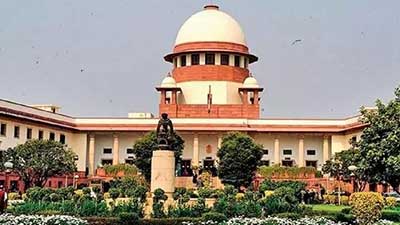Date : 29/11/2023
Relevance: GS Paper 2 – Indian Polity
Keywords: Law Commission, CJI, Kesavananda Bharati case, Article 145
Context-
In a landmark move on September 20, 2023, Chief Justice of India (CJI) D.Y. Chandrachud unveiled plans to establish Constitution Benches of varying strengths, signaling a potential transformation in the Supreme Court's structure. The announcement comes at a crucial juncture when the judiciary is grappling with challenges like mounting case backlogs and concerns over the autonomy of judicial appointments. At present, there are 79,813 cases pending before the 34 judges of the Supreme Court.
Historical Perspectives:
The idea of restructuring the Supreme Court isn't novel. The 95th Law Commission Report in 1984 advocated for a split into two divisions: Constitutional and Legal, a proposal reiterated in the 125th Law Commission Report in 1988. Even earlier, in 1978, Rajeev Dhavan proposed a two-division system in his book, "The Supreme Court Under Strain: The Challenge of Arrears." Despite these recommendations, the structural reforms remained dormant.
Former Chief Justice Ranjan Gogoi echoed similar sentiments in 2019, but progress during his tenure was limited. Notably, during the brief 74-day tenure of former Chief Justice U.U. Lalit, 25 Constitution Bench matters were listed before five-judge benches, hinting at a renewed momentum. CJI Chandrachud's recent announcement appears to build on this momentum and opens a window for revisiting the structural organization of the Supreme Court.
Constitution Bench Pendency:
Article 145(3) mandates a minimum of five judges for a Constitution Bench. According to the National Judicial Data Grid, there's a significant backlog in five, seven, and nine-judge bench matters. Since January 2023, a five-judge bench has convened monthly, except during the Court's vacation in June. On October 4, 2023, a seven-judge Constitution Bench assembled to deliberate on whether legislators accepting bribes for influencing votes enjoy immunity, highlighting the significance of such benches in addressing critical issues.
The historical context of nine-judge bench decisions dates back to 1950, with 17 decisions rendered thus far. However, several crucial cases, including those related to essential religious practices like the Dawoodi Bohra excommunication, Parsi excommunication, and the Sabarimala review, are pending before a nine-judge bench. This backlog emphasizes the need for a structural overhaul to streamline the adjudication of cases based on jurisdiction.
Dividing Functions: Constitutional vs. Appellate:
The Supreme Court, as per the Constitution, operates under three jurisdictions: original, appellate, and review. The Kesavananda Bharati case in 1973 introduced a basic structure of jurisdiction. Presently, the Court combines constitutional (writ and basic structure cases) and appellate (appellate and review cases) functions without a clear structural demarcation. Benches of varying strengths are set up under the Master of the Roster's instructions, leading to an overemphasis on appellate functions and an underdeveloped constitutional court function.
Drawing inspiration from other jurisdictions like Egypt, Germany, and Italy, where functions are divided between institutions, the proposal to establish permanent Constitution Benches aims to bring stability and judicial consistency. This would enable cases under constitutional jurisdictions to be distinctly handled from those under appellate and review jurisdictions.
Regional Benches: Addressing Accessibility:
A significant concern is the accessibility of the Supreme Court, as highlighted by former Chief Justice N.V. Ramana during his 16-month tenure in 2021-2022. No Constitution Benches were assembled during this period. To address accessibility, CJI Ramana proposed the establishment of regional benches, with the Delhi Bench focusing on constitutional matters. This proposal aims to decentralize the Court's functions and make justice more accessible to citizens across the country.
The 229th Law Commission Report in 2009 suggested four regional benches located in Delhi, Chennai or Hyderabad, Kolkata, and Mumbai. Each region would have six judges, totaling 24, handling non-constitutional issues. The Constitution Bench in Delhi would continue working on constitutional matters of national importance. The proposal aims to alleviate the backlog of non-constitutional cases and make the Supreme Court more accessible to a wider section of the population.
Digital Courtrooms: A Game-Changer for Regional Benches:
While earlier proposals suggested physically relocating benches, the advent of digital courtrooms, accelerated by the pandemic, offers a viable alternative. CJI Chandrachud could leverage this technological advancement to designate some appellate benches as regional benches without the need for physical relocation. This move could potentially address regional disparities in accessing the Supreme Court and enhance overall efficiency.
A Viable Path Forward:
The proposed structural reforms encompass two key aspects: the separation of constitutional and appellate functions and the establishment of regional benches. While a constitutional amendment could achieve the former, an alternative path is amending the Supreme Court Rules under Article 145. This pragmatic approach, requiring the President's assent, presents a feasible route with lower political barriers to reform.
CJI Chandrachud's tenure provides a unique opportunity to reshape the Supreme Court structurally, fulfilling the promise of being a court for all Indians. By implementing these reforms, the Court can enhance accessibility, reduce pendency, and clarify its role and functions.
Conclusion
The Chief Justice of India, D.Y. Chandrachud's recent announcement to establish Constitution Benches with varying strengths marks a significant step towards potential structural reforms in the Supreme Court. Examining historical perspectives, the backlog in Constitution Bench matters, and the need for clear demarcation between constitutional and appellate functions, this article advocates for the establishment of permanent Constitution Benches and regional benches. Leveraging technological advancements, particularly digital courtrooms, presents a viable solution to address accessibility issues. Through an amendment to the Supreme Court Rules, CJI Chandrachud has the opportunity to usher in transformative changes, ensuring the Supreme Court remains a beacon of justice accessible to all citizens.
Probable Questions for UPSC mains Exam-
- Evaluate historical proposals for restructuring the Indian Supreme Court, considering challenges faced by past Chief Justices. Discuss the potential impact of Chief Justice D.Y. Chandrachud's recent announcement on reforms. (10 marks, 150 words)
- Assess constitutional challenges in the Indian Supreme Court, emphasizing the backlog in Constitution Bench matters. Evaluate proposed reforms, including permanent Constitution Benches and digital courtrooms, and discuss their anticipated benefits. (15 marks, 250 words)
Source- The Hindu









